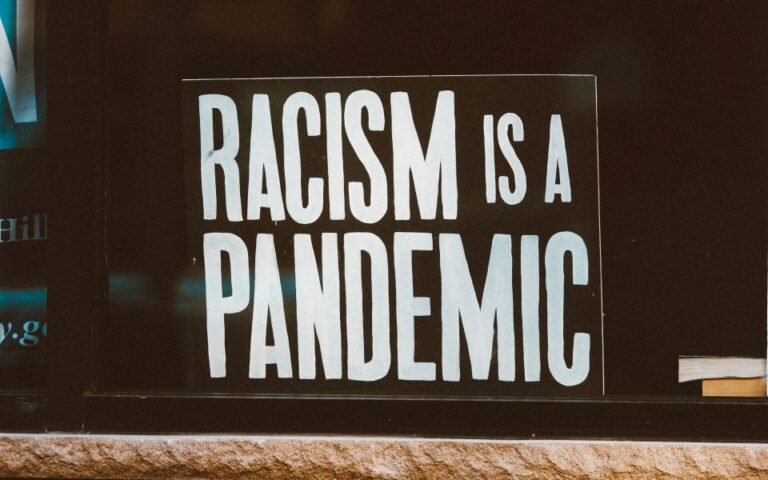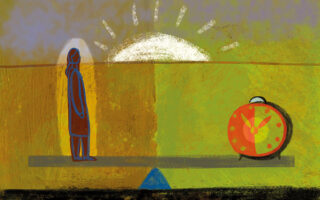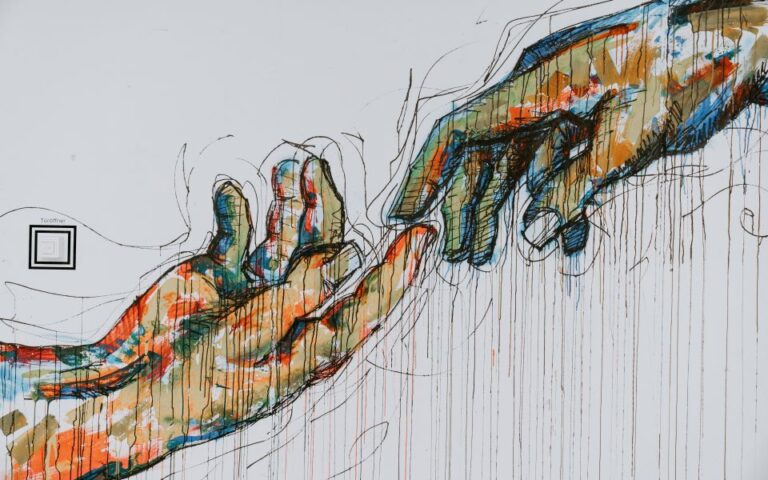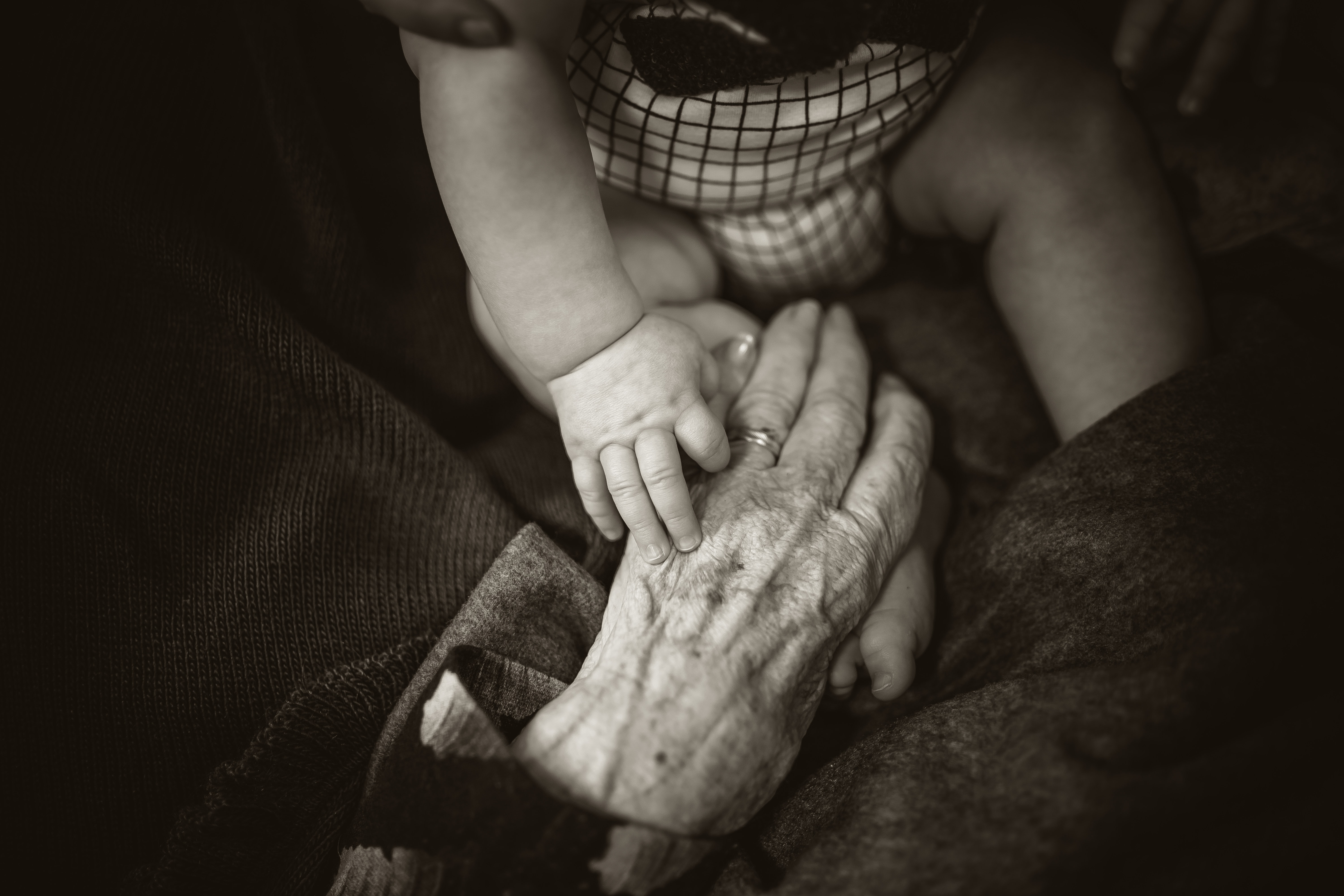Our editor Jon Sutton meets Dr Ben Alderson-Day, author of Presence: The Strange Science and True Stories of the Unseen Other. Plus an extract from the book.
02 February 2023
Dr Ben Alderson-Day is Associate Professor at Durham University and author of
Presence: The Strange Science and True Stories of the Unseen Other.
Early in the book, you write that ‘Psychology has presence in its bones’.
Yes… some of the earliest psychologists were interested in topics like presence. William James, in Varieties of Religious Experience, talks about this distinct feeling that acquaintances of his had had… a feeling that someone was there in their nearby environment, without any clear sensory evidence for why they would feel like that. A friend of his, when in college, would have this distinct thing at night – a visitor in the room, which would give him this chilling feeling, something uncanny, unearthly almost.
James wrote that presence is ‘more deep and more general than any of the special and particular senses’, and he was vitally interested in how we account for that kind of experience within a psychological framework.
You see that kind of interest elsewhere as well. Members of the Society for Psychical Research, working at Cambridge in the late 19th century, were people who were described themselves as scientists, but wanted to understand the limits of mind and brain in terms of things like telepathy, premonitions and these really vivid, hallucinatory experiences.
So these experiences are occurring outside of the normal five senses: we're not actually seeing or hearing something, it's just the sense that we have?
That's right. If it was just about capturing something out of the corner of your eye, or hearing a sound from another room and thinking ‘maybe someone’s there’, I don't think there would be any story or mystery: we've all had that kind of experience. But when people describe these
feelings of presence, they stumble over their words and just land back on this very basic feeling… they just know that somebody's there, they just have this sensation. It's not about hearing, seeing, or touch. It's this visceral, bodily sense that you're in the presence of somebody else.
And the way Shackleton talked about it in terms of Antarctic expeditions, it’s not only that he struggled to explain it, he almost felt that he shouldn’t try. That must be a pretty difficult thing to research and to write about.
That's right. I've often wondered why I chose to write a book about something which can't really be explained or measured. It's been a challenge!
Shackleton's experiences on the Endurance expedition are perhaps the most famous examples of the felt presence phenomena. People might know them as the ‘third man effect’ or the ‘
third man factor’. Shackleton, along with two of his crew mates, Frank Worsley and Tom Crean, recounted this vivid feeling that they had a companion with them when they had to trek across the interior of South Georgia Island in 1916. It was a 36-hour trek and they had to make it to the other side in order to save the rest of their Expedition. They were very reticent to say much about that experience. They referred to it obliquely in their accounts years afterwards, sometimes describing it as providence coming in to save them. It comes down to that feeling that, in Shackleton’s words, ‘often we were four, not three’. Later on, Shackleton told a British journalist that there were things that happened which can never be spoken of, as if it went beyond ordinary knowledge, the things that we think we know about the world… as if they'd crossed over some the threshold. And that's true of lots of accounts of spiritual, almost transcendental presence… something is so unusual, and feels so significant for the people experiencing it, that they also feel like ordinary language just doesn't scratch the surface.
And in hearing those stories and seeking to understand them, do you think your background in Philosophy as well as Psychology came in handy?
I wasn't particularly good Philosophy student! But I think that curiosity about the possibilities of experience and the ways in which people might experience the world being very different to your own, philosophy was a good training in that.
I was also part of a
big interdisciplinary project at Durham, working with people who would describe themselves as voice hearers, who may have had a psychosis-related diagnosis. You need to talk to them carefully, in an exploratory way, to try to get a sense of what's going on there. You go beyond preconceptions we might have about the way in experience has to be, or the way it's supposed to be according to a textbook. That was my route to thinking about presence. This was something that was going on for people that they found very hard to describe, and weren't usually asked about by clinicians or researchers in the context of psychosis.
In the book it seemed the presence on expeditions did tend to be positive and supportive, unlike a lot of voice hearing experiences in psychosis. I’m convinced if I was on an expedition, I'd have a felt presence saying, ‘Well, this was a bloody stupid idea’.
Certainly it's part of the legend of the third man effect, that this presence arrives in the nick of time… the companion that gets them back down the mountain or off the glacier. But it’s the stories that don't meet expectations or standard narratives that I've always thought more interesting. And indeed, when you talk to people who've had these experiences in endurance situations, there's often an element of ambiguity, ambivalence, confusion.
I talked to Luke Robertson, the first Scot to ski solo to the South Pole. He just happened to be married to a friend of mine, and I was standing in his garden one day, and he told me ‘oh yeah, hallucinations, I had those when I went to Antarctica’. So I asked if I could talk to him about his experiences. A whole range of things happened to him on this 40-day trek. But the most interesting for me was two presences that visited him. One of them was your conventional one, that came on two different occasions where he was about to fall asleep or give up, a presence that came to him and made him get up and keep going. But he also had this other presence that had appeared slightly earlier on the trek, that would just shout his name repeatedly from behind him. He felt he had to look over his shoulder and check that nobody was there. He knew, rationally, this was his mind playing tricks on him. And yet he turned around every time because he also felt if he didn’t, this presence would catch up with him, tap on his shoulder, and his heart would stop – he’d had a pacemaker for a few years, so this was clearly a point of vulnerability for him.
By the end of the trek he felt he was responsible for this presence, he was leading them, and then that first presence was leading him. That doesn't really fit the conventional narrative about being saved by a guardian angel. That prompted a lot of questions for me, about this combination of expectations and needs, or whether something more complex is going on.
In terms of that complexity and how the mind plays tricks… in the book, snow plays quite a prominent part. Snow is fundamentally a kind of white noise. And other pursuits where felt presence tends to happen include caving and diving… expanses of nothing. Do those environments lead you towards the explanation that the trick the mind is playing is to impose order on chaos? Are there stories of felt presence in the jungle, where the environment is more visually varied?
Undoubtedly, certain environments seem to prompt these experiences. Expanses, monotony, things that essentially create a form of sensory deprivation. All of those things can prompt different kinds of hallucination, illusory phenomenon. So going back to Luke, the first thing is he starts to see the green hills of his home in Scotland, just very quick visual hallucinations. In this massive white expanse, your mind starts filling in the gaps. But the other thing that's happening is that your body is in that environment. The boundaries of your own body are being challenged or changed. People are really pushing themselves to their limits. You’re not this passive observer of the world, you're a moving organism going through it, that's having to keep track of where it belongs and where it stops and the world ends.
It's funny you should bring up the jungle. A last chapter of the book was actually going to be about psychedelics, and in particular the experiences people have taking Ayahuasca in the Amazon. People have a range of what we might describe as presence-like experiences, along with a lot of auditory and visual hallucinations. But they are also massively changing what's happening with their body: purges, lack of sleep, going to the toilet loads. It's only after you've done all that to your body that you start to get the most vivid experiences. So it's about what's happening to you on the inside as much as what you can see and feel on the outside.
That fits with the chapter around sleep paralysis… you wake up and can’t move, so something is going on with your body that you can't explain, and then the environment is dark which can prompt a sense of fear and foreboding. That was my own felt presence experience in 1996… I sensed Death in the corner of the room saying ‘I've come for you now’. At the time, I hadn't heard of sleep paralysis – which is kind of funny, because I was in the Goldsmiths Psychology department with Chris French, and it’s become a running joke between us that sleep paralysis is his explanation for everything. But sleep paralysis is fairly commonplace, it does seem to be at the root of a lot of anomalous experiences, yet it doesn't seem that widely known or talked about. I find that interesting, in terms of the levels of explanation that people are perhaps looking for and that they're comfortable with.
You’re right, the vast majority of people who experience sleep paralysis often don't talk about it and don't realise what it is. It affects around 7 per cent of people across their lifetime, and about half of those people will have a felt presence. It's the most common kind of hallucination that occurs in the context of paralysis, and we just don't know why. There's no inherent reason why being in that state of paralysis would lead to such a vivid hallucinatory experience… often a real sense of who that figure is, and malevolent intent.
So sleep paralysis gives you that battleground of a few different theories. You've got elements of predictive processing or expectation, you've got disruption to your bodily cues and where your body should be in space, and you've just woken up, most likely from REM sleep. You’re filling in the gaps with a brain that might still be dreaming, even though you feel like you're awake.
So it's possible to create an account of sleep paralysis, which is purely about the context of sleep. But what we want is an account that joins the dots with Shackleton, with the experiences of psychosis, with the things William James was talking about. That was something I grappled with in the book: are we talking a collection of things which sound the same, but might ultimately be different?
The book really came across as an exploration of the scientific process. You describe it as ‘an itch that needed to be scratched’, ‘to put a name to a phantom’. Was each step on that journey supported by the research process?
There were steps along the way, but they weren't always in the right order, or the order that they appeared in the book. Some bits I had to pick up along the way, like talking to Leven Brown, who had these experiences as he rowed the Atlantic. Stories I hadn’t heard before that I needed to hear for myself.
In terms of the research side, we started to explore presence through our work on psychosis, and then expanded out in a few different directions at once. We had a paper that came out last year in
Psychological Medicine, where we compared some online surveys of people who were just asked to tell us about their presence experiences, and quite a high proportion of that group had some form of mental health diagnosis. And then we had two other samples – people from spiritualist communities primarily in the UK, and people from sports societies that tended to do solo endurance activities. We wanted to start to get to that question: one presence, or many? The overriding message was there's a lot of commonality. You're more likely to have felt presences if in general, you are hallucination prone: if you’re likely to hear voices, see visions, you've had a lifetime of these unusual phenomenon. And that's true of people in all three of those samples. There's no specific thing that only happens in a clinical context, or with those spiritual presences. There's a lot of overlap, as if there's a general predisposition to this in the population.
That predisposition… is it in terms of ability to spot stimuli and patterns, that sort of thing?
That's broadly how I would understand it. The framework for our research is that people's perceptions of the world are governed by slightly different rules each time, and some people will have a greater tendency to see patterns in the world and make meaning from things that other people will consider meaningless… pareidolia, for example. And then there are people who don't experience the world in that way. Imagine a lifetime of being at one end of that spectrum of that, where you're always the person that sees something that other people don't.
We worked with people who would describe themselves as mediums or psychics, and a lot of people would be skeptical about the kinds of abilities these people would describe [see extract below]. But when you talk to them about their lives, it's clear they’ve had a whole childhood, an autobiography of the uncanny. Their perceptions were always slightly different from other people. They were tuned to a slightly different frequency, and I guess that does come back to information processing, literally about looking out at the world through different eyes.
And there are cultural differences in that, right? You talk about the work of Tanya Luhrmann, Professor of Anthropology at Stanford, and she compared cultures to highlight that the American view is ‘your mind is a castle, not open to visitors,’ whereas with plenty of cultures that's not seen as the case.
That
particular finding of Tanya’s was in the context of hearing voices in people with psychosis in America, in India and in Ghana. She argued that the model of mind you had in your local culture made a difference to how you'd react if unusual experiences started to occur. If things weren't allowed to pass through in that way, if you couldn't have the thoughts or ideas or words of somebody else in your mind, then it would feel like a real violation. And that's how she would describe the American sample. Whereas with the people that she spoke to in India and in Ghana, there was this sense you could receive an idea or a thought from somebody else in a way that went beyond our usual sensory understanding.
It's important not to imply a dichotomy: there's lots of overlap as well in unusual experiences across these different cultures and societies. But there is something quite interesting about the idea that your own preconceptions about what is possible will guide your reactions. If somebody else is in there with you, and you haven’t got the framework to explain why, then it's going to be a much more startling experience.
It's time for me to drop a stupid question. Are felt presences always animate – people, animals, spirits? How come I don't get a sense of presence of a watering can sat in the corner of the room?
It's actually a good question, because it gets at what we really mean when we say ‘presence’. We could say the sofa feels present, it has a presence in the room, but we don’t talk about it in that way. We talk about presence as another form of agency in the world around you: something that could act of its own accord, something that has implications for how you act, for your own safety potentially, or for your own relation to the world. The presence of another agent in your space changes your set of possible worlds or actions. If you're in my space, I can't move in the same way, I can't pick up the same things, I can't make the same decisions. It matters if another agent is around us. We can't control or predict actions in the same way. We're not as sure about our environment. So with good reason we're very good at detecting agency in the world around us even from very basic cues. It’s that basic feeling that presence is picking up – it's not just something that is there, it’s someone.
And to what extent do you think that someone is always an extension or a reflection of yourself?
There's good evidence that quite a few presences probably have their basis in that. Maybe the most developed theoretical account of presence comes from the work of people like Peter Brugger and Olaf Blanke, who showed through lesion studies and single case examples that sometimes people could have very vivid experiences of a felt presence with a specific location around them, and often a bodily form, that usually can be shown to be the result of some disruption to their own body mapping. The classic example was a paper by
Shahar Arzy and Blanke in 2006, where they stimulated the left temporoparietal junction of a woman who was having a pre-surgical evaluation for epilepsy treatment. Through stimulating this area – up and behind the ear, the nexus of three different lobes in the brain – she started to have this feeling of a shadow figure immediately to her side, essentially mirroring her body position in some way. That area is integrating a load of different sensory information, essentially telling us where our body is supposed to be in space. Disrupt that, and we can end up with these mirrors or projections.
Now, it could be that many examples of felt presence are essentially this kind of mirror projection in some way. But that account on its own misses this feeling of emotional significance or identity… the social side of presences. We need something else.
So change the body map and you can show the other, but who or what that other is is likely to be heavily influenced by your past experiences, current situation, all sorts of social aspects.
Tulpamancy: what's that all about?
It’s a relatively new phenomenon in its current form. It grew out of Reddit communities surrounding My Little Pony, with people sharing tips on how to create your own sentient being inside your mind that you could interact with. Some people describe them almost like adult imaginary friends, but tulpamancers would be concerned about an overemphasis on imagination. Certainly, they start with very vivid, imaginative practices, and also doing things that might look similar to meditation in terms of lots of guided attention. With practice over and over again, they try to conjure up this ‘other’. But what happens over a few months is that they end up creating this ‘tulpa’ that can talk back to them, that they can interact with. I mention an example in the book of somebody saying it's like two minds looking out through the same set of eyes. Tulpamancers talk about it being really hard to stop their tulpa being around once they've been created.
For me, it really shows the mind can go so far in creating phantom others, unreal others. It speaks to one of the most complex capacities of the human mind, which, though it might sound unusual, is happening all the time: for example, in the context of people writing fictional characters or other forms of creativity. It’s not uncommon for authors to talk about characters speaking back to them.
You've done research on that as well.
That's right, we did
a collaboration with the Edinburgh International Book Festival a few years ago, where we interviewed and surveyed authors to ask them about their experience of their characters’ voices. It was led by John Foxwell, who's an English literature scholar. The interesting thing was that a third of writers were absolutely adamant that if a writer said their character spoke back to them, they were liars, that this is just a myth about writing. And then about a third said this happens all the time: it's proof that the process is working, they don't feel like a character works until it starts to speak for itself. They would say that characters will correct them if they write something about them which doesn't quite fit. The character emerges, just like creating a Tulpa. It's a gradual thing, almost like handing over your agency to something, or somebody, else.
Famous writers have talked about characters in this way. David Mitchell, Charles Dickens… writers talk about a character hanging around after the book is written, and having to clear them out the way to approach a new one. It’s something that happens for people and happens in a really vivid way, but we're only just beginning to understand what might be happening there psychologically.
You seem very open minded about how you approach research topics. Reddit forums with people trying to conjure My Little Pony characters, might seem like nonsense… whereas the great authors of fiction talking about characters seems more legit. But you're seeing the similarities between the two processes and letting the stories speak for themselves.
For these kinds of phenomena, you can't really afford to be too precious or kind of rule things out from the beginning. You're still working out what the phenomena is. You need to triangulate from a number of sources, draw on all you can, because it's a challenge enough to describe an experience like presence. If you see the same things happening in different contexts, often performing the same functions for people, arising in the same way or having similar tropes, you start to get a handle on the core of the stuff we're trying to describe. These are the things which are specific to those contexts, these are the weird examples that maybe point to a different direction… like tulpamancy. If you can have these presences of the imagination, does it make sense to connect them up with some of the other presences we've talked about, like presences of the body that come out in survival situations? It could be that we're talking about two different things. Or it could be we're talking about this spectrum of what happens when we start playing with the boundaries of the self in different directions, and in different ways. Maybe we can conjure ‘the other’ in different ways as well.
I felt a bit sad by the end of the book that you didn't seem to have conjured ‘the other’ yourself. Presumably that will be pretty big day if that happens.
I'm rubbish at hallucinatory or unusual phenomena. I never have any of these things. I've had sleep paralysis after eating too much at a family wedding, and then sleeping in a converted barn… I've never met cows like these, they mooed at each other all night. After a while on a loop of shallow sleep and cows, I realised I was paralysed. My first feeling was ‘right, here we go’, I brace myself thinking, you know, maybe I'm going to get Death at the end of the bed. And it never came. I was just stuck there listening to those cows.
Presence: The Strange Science and True Stories of the Unseen is published by Manchester University Press on 21 March. The following extract is with their kind permission.
The presences of grief
The concerns of the Society for Psychical Research [ set up in London in 1882, the first scientific organisation ever to examine claims of psychic and paranormal phenomena], and of men like Harry Price, may seem a world away by today’s standards. Concerns of mediumship or visits by poltergeists feel very much of their time – and parapsychological research tends to sit at the fringes of experimental psychology today. What, then, is relevant here for understanding felt presence?
The first point is that such accounts perhaps come closest to what many people think of when contemplating something like felt presence. Presences that we cannot see or hear, and yet whose arrival cannot be mistaken; presences that inhabit and haunt certain spaces and times, creating atmospheres of their own. In the popular imagination, presences often mean spirits or ghosts. And according to some estimates, belief in ghostly encounters has risen in the post-war period. In the UK, for example, one study reported that approximately 15 percent of adults endorsed such beliefs in the 1950s, compared to over 30 percent in the 1990s. Moreover, such stories still get shared and recounted, and the trope of the ghost story, or after-death encounter, is a familiar one that many people will hear.
These might seem like fringe experiences – but that doesn’t mean they are uncommon.22 In 2020, I was part of an international working group that reviewed the evidence of people reporting experiences of the deceased during bereavement.23 A lot of the data available is quite piecemeal, and it can be hard to run large-scale, systematic research on the topic. As with many of the experiences that we have heard about so far, people can be reluctant to talk about them. They might be concerned about how the listener will react, worrying that they will be misunderstood or even laughed at. They might not be able to make sense of it themselves, and their experience – like those of sleep paralysis – might clash with what they hold to be possible. And yet, these incidents can have huge significance for people.
In our 2020 review, we referred to these accounts as “sensory experiences of the deceased,” or SEDs. Based on the data we do have, there were some things that we could say with some confidence:
(1) Felt presence is a common (perhaps the most common) kind of SED. In survey work of bereavement phenomena, the simple feeling of presence (absent of any clear sensory cues) occurs most frequently, followed by auditory experiences, and then visual experiences. The presences reported are sometimes very clear – in taking up a particular position in space, for example – but sometimes are more diffuse and abstract. One of the review authors, Edith Steffen, had conducted a small study in 2011 where people described their experiences. One person said, “It wasn’t a physical thing. I didn’t feel anything physically. But I felt it so strongly. I felt him.” Another was more specific: “You know, it wasn’t like a shadow or anything. She was literally there at the bottom of my bed.”24
(2) The relationship of SEDs to past experience is . . . complicated. While for many the feeling might be comforting, SEDs can include the persistence of unpleasant people and relationships. This was a surprise to me, and it’s something that one of the other review authors, Jacqueline Hayes, has drawn attention to in her research.25 It’s an important observation because it suggests that the driver of such experiences cannot just be coming from the emotional needs and desires of the subject. If SEDs only ever occurred in people who were grieving for someone who they dearly wished was still around, it would not be very surprising that these kinds of experiences occur. Longing, isolation, and reminiscence can work powerfully upon an individual; a lifelong partner will stay in that chair if you only keep them in your imagination.26 But for others, complex – and even abusive – relationships may continue, and it might be a focus of psychotherapy to break the bond with the deceased in some way.27 These, however, are not representative of the majority of bereavement experiences. In fact. . . .
(3) The majority of these experiences are benign. There is a historical concern that persistent experiences of this kind represent a kind of disorder – in other words, a problem in how grief is being processed by a person. There are diagnoses – such as persistent complex bereavement disorder and prolonged grief disorder – that have been studied in relation to SEDs, but the evidence to suggest a strong association with pathology is not there. It would generally be a mistake to think about these experiences as necessarily being problematic – even if, for some people, they can become a problem.
We can’t say how common bereavement-based experiences of presence are, and we know from international research that they can vary considerably across different countries and cultures.28 The point here is to emphasize that these experiences are still happening, in 21st-century Western societies. The time of the SPR might seem like ancient history, but if we were to run a Census of Hallucinations today, focusing on similar experiences, who knows what kind of response we may receive?
Many people out there might be looking for a kind of connection with the deceased – even if they themselves wouldn’t necessarily say that they believe in life after death or the physical reality of spirits. If that kind of connection is sought, and if it doesn’t happen spontaneously, they might choose to see a medium. And sensing presence – understood fundamentally as a kind of spirit – is still a key part of the modern practice of mediums.
The presence professionals
Mediums and psychics are often called “clairvoyant.” In fact, clairvoyance is only one component of the ways in which spirits are encountered, referring to visual experiences specifically (hence the association with “seeing” the future). In our research at Durham University, we were often most interested in people with a second kind of sensation: “clairaudient” experiences, or experiences of sound and language that indicate the presence of spirit. We chose this focus because our research was mainly geared toward the phenomenon of hearing voices, so clairaudience would in theory be a close parallel. Often occurring in tandem with clairvoyance and clairaudience is “clairsentience,” when people experience a basic feeling of spirit and the knowledge that it can bring. Clairsentience is not necessarily reliant on any of the classic five senses but comes from something separate entirely.
You might think that doing research with people encountering these phenomena would be a waste of time. Lots of people think that self-described mediums are “putting it on,” that their work depends on offering something to people at a time when they are emotionally vulnerable, i.e., during a period of bereavement. I understand that response – and if I’m honest, I have met some people who have prompted that reaction in me – but it wasn’t the view we took among our team at Durham. We approached the topic with the starting assumption that people were having some kind of unusual experience. The subjects might interpret it as a supernatural encounter or believe in an explanation that didn’t fit with ours, but we took it on good faith that they were having experiences that they couldn’t easily explain otherwise. And we fundamentally wanted to know what the experience was like – not what caused it necessarily, or how it could be debunked, but how it felt to them in the immediacy of the moment.
Between 2016 and 2019, our team conducted a series of interviews with people who had regular experiences of clairaudience, with voices speaking at least once a month. The subjects couldn’t have been diagnosed with any mental health condition that might be associated with hearing voices or similar phenomena. Many respondents were practicing mediums, and some, but not all, were recruited via the Spiritualists’ National Union, the largest organization of people with spiritualist beliefs in the UK.
One of the things that quickly became apparent in conducting our interviews was that many of the experiences of spirit were not confined to one sense. Often a sign in one domain would then be followed by another; voice would follow vision, a thought could lead to a tingle or a brush on the shoulder.29 Some people would not have any experiences in one particular sense – like clairvoyance – but many had a mixture. And all were skilled at detecting a spirit, in any form that it would come – including as a felt presence.
A colleague of mine, Dr. Peter Moseley, led the study. If the subject of presences came up in the interviews, we would typically ask people to define what they meant by that. The response would often include descriptions similar to those we have come across already in the preceding chapters of this book. Some would describe proximity, a kind of bodily awareness that another person was in the immediate vicinity:
I guess it’s just like if someone’s standing close to you, you don’t have to look to see if there’s someone there. . . . You just know that there’s someone close to you. I’ve had some quite distinct experiences like that, where I’ve felt the presence so close, it’s as if it’s out, it’s here, I could almost touch it.30
Sometimes this feeling was more like an energy of some kind, marking that another was there:
Just a feeling that you’re accompanied by an essence. Not necessarily the way it would feel with a solid person there.
Often, that feeling of an energy was tied to emotional states associated with the character of the person present.
The very starting point is I’ll usually just feel the presence of the communicator and depending on what their personality was like, I’ll almost feel that they’re really close, they’re really far away, if they’re a quiet person.
In most cases, the people we spoke to were seeking to connect with the spirit world to receive messages that were for other people – people who had come to see them, exactly to hear such “communication.” But in some cases, that sense of presence, and that emotional connection, concerned people the mediums knew themselves, people they felt emotionally close to, and often people they had lost.
I think when it very first started, if I’m honest, was a bereavement like of my partner . . . her uncle passed, and whilst I wasn’t particularly close, I almost found it affected us. . . . I just found I was grieving even more than that I even expected. And then after that, within a few weeks, I started feeling presence after that, and that’s when I thought there’s sommat maybes not quite right.
I know very distinctly one day I felt my father sit, I really felt him sit down beside . . . and it came completely out of the blue, I wasn’t expecting him, and I was preparing just quietly for a service,
because usually when you’re preparing, the medium goes into the back room before the service, if they want to, just to sit quietly and attune as they do. I was sat down, and I suddenly felt his presence and I felt his hand go into mine.
One of the things we were interested in was how spiritualists develop their skills as a medium. One participant in particular was very specific about how she cultivated her skills.
I teach students how to be more focused, rather than just kind of mentally picking up telepathic thoughts, which is what a lot of psychics can do, picking up thoughts, not just from the spirit world but from people around them. How I’ve started to try and teach students who are very erratic is to imagine that they’re in a room with a door behind them, and when they’re ready to, to invite the spirit world to link with them, to kind of give permission to open the door and let them in – but it’s into a space, by getting them to imagine a room. And so initially, as you feel that presence, what does the presence feel like? Don’t worry too much about the communication, get the presence, build the connection, and then allow the communication to start to flow, in whatever way is going to work for them, because it could be very different for everybody. So in my own way, I do that, but I don’t have a room and a door, but I have this space that I focus into. And I shift my whole focus from my physical presence and place where I am into being aware of another dimension of life. I’m focusing into that space. I don’t quite know how to express it any clearer than that.
In some ways, the presences of mediums are not so different from those in many of the accounts we have heard so far. Presences feel like someone close by, within touching distance even. An energy, an identity, an intent, or a personality. Like a physical person, but not quite. And often someone significant; someone lost, or someone needed.
But at the same time, it is important to acknowledge that something potentially quite different is going on here: these are presences that are cultivated. They are sought for, teased out, sensed before they appear. People must learn to find them in many cases; they must know what to look for, what clues to pay attention to. They often identify an “energy,” but what does that mean? Some kind of awareness, a redirection of attention. Like in the final quote above, a turning away from themselves and their own physical space and out into . . . well, the ether, as it is sometimes called.
That searching, that need to learn, would set off a whole set of alarm bells for most psychologists. Indeed, many scientific researchers would question the worth of thinking about these experiences at all. Aren’t they just an extension of folk beliefs, elaborate displays of wishful thinking, vivid imaginations, and even collective delusions?
If we assume that mediums are having these kinds of experiences, a key chicken-and-egg question arises: What came first, feelings of presence (or other apparent visitations) or the will to believe that such things are possible? In other words, do people become mediums because they have such experiences or because they want to have them?
Two members of our team, Pete Moseley and Adam Powell, further explored this question within the spiritualist community. In a 2020 survey, they found that about two-thirds of a sample of 65 spiritualists reported having unusual experiences from a young age, sometimes decades before becoming aware of the spiritualist movement or attending a spiritualist church.31 Since childhood, they would see and hear things other people could not, like they lived in a different sensory world. The overriding impression of the survey results was that experience was coming before belief: a special connection or skill, an affinity with the spirit world, which led people to develop spiritual beliefs about the world. They didn’t go looking for presence; presences came to them.
Of course, there is still a worry about the authenticity of these results, that they rely on what people simply want to tell us – people might recount experiences of having this skill from a young age in order to elevate their own self-perception. What is more powerful, being a natural or being a striver? Will someone believe you if you said it took you ten years to connect with a spirit, but eventually you did?
We don’t have to rely solely on what people say, though. We also know from other scientific research that people from these groups can learn about sensory signals in sometimes very unique ways. A study run by Phil Corlett and Al Powers at Yale University in 2017 showed that people with schizophrenia who hear voices are susceptible to a certain kind of conditioning for hallucinations – but so are psychics.32 The concept of conditioning, as famously demonstrated by the early psychologist Ivan Pavlov, involves forming a strong association between a stimulus and a response. With enough training, many kinds of responses can be conditioned – even the tendency to hear and see things that are not there.
In the Yale study, participants learned to associate a tone with a faint visual signal, then the tone was gradually removed during the experiment. Participants then had to report if they heard the tone when presented with the visual cue, and some people would still hear the tone just based on the visual stimulus appearing (i.e., no sound was actually played). In other words, the illusion of sound had been conditioned. Both the patients who heard voices and the psychics were more likely to hear the tone even when no sound was there. People with schizophrenia who didn’t hear voices and healthy control participants were less likely to experience the conditioned hallucination. This pattern of results is key, as it suggests that having a schizophrenia diagnosis isn’t the thing driving the results; instead, it’s the tendency to hear voices, whether you are a patient or a psychic. Something similar seems to be going on in how perception works for psychics and people with schizophrenia who have frequent hallucinations. Whatever is occurring might set these groups on a different path to the rest of us.
But even so, these kinds of findings only slightly loosen the Gordian knot in front of us. How can we possibly separate the experience of hearing spirits or feeling their presence and the set of beliefs that surround it? When we know that some people are looking for this kind of experience – training themselves even – how can we be confident about what is happening to them? Understanding hallucinatory experiences seems hard enough, but understanding them when people actually want them to occur – and separating them from imagination, desire, memory, even dreams – feels dauntingly impossible. I needed to enlist some help, to talk to someone with experience of this kind of knot – someone with decent scissors (or perhaps even a set of knitting needles). …
Footnotes
22. R. Gill, C. K. Hadaway, and P. Long Marler, “Is Religious Belief Declining in Britain?” Journal for the Scientific Study of Religion 37, no. 3 (1998): 507– 516.
23. K. Stengaard Kamp, E. M. Steffen, B. Alderson-Day, P. Allen, A. Austad, et al., “Sensory and Quasi-sensory Experiences of the Deceased in Bereavement: An Interdisciplinary and Integrative Review,” Schizophrenia Bulletin 46, no. 6 (2020): 1367– 1381.
24. E. Steffen and A. Coyle, “Sense of Presence Experiences and Meaning-Making in Bereavement: A Qualitative Analysis,” Death Studies 35, no. 7 (2011): 587, 588.
25. J. Hayes and I. Leudar, “Experiences of Continued Presence: On the Practical Consequences of ‘Hallucinations’ in Bereavement,” Psychology and Psychotherapy 89 no. 2, (2016): 194– 210.
26. In response to Chan and Rossor’s 2002 Lancet essay (see chapter 6), the Israeli doctor Avi Ohry wrote of being visited by his wife and best friend when in jail for five weeks in Egypt, only for his visitors to disappear when the guards arrived (A. Ohry, “Extracampine Hallucinations,” The Lancet 361 [2002]: 1479–1479).
27. There is a form of therapy practiced by a small minority in the UK known as “spirit release” therapy, in which an unwanted presence is made to move on from visiting a person. See, e.g., A. Powell, “The Contribution of Spirit Release Therapy to Mental Health,” Light 126 (2006): 10–16.
28. A famous Swedish study reported felt presences in over half of a sample of fifty older adults (Grimby, “Bereavement among Elderly People”). However, problems of selection bias and reluctance to report such experiences makes estimating their prevalence highly challenging.
29. P. Moseley, A. Powell, A. Woods, C. Fernyhough, and B. Alderson-Day, “Voice-Hearing across the Continuum: A Phenomenology of Spiritual Voices,” Schizophrenia Bulletin 48, no. 5 (2022): 1066–1074.
30. Hearing the Voice, 2021. The Hearing the Voice Spiritual Voices Interviews, Durham University, unpublished.
i. “I guess it’s just like if someone’s standing close to you . . .” is from Interview 19: 9.
ii. “I’ve had some quite distinct experiences like that . . .” is from Interview 10: 9.
iii. “Just a feeling that you’re accompanied by an essence . . .” is from Interview 16: 9.
iv. “The very starting point is I’ll usually just feel the presence . . .” is from Interview 4: 9.
v. “I think when it very first started, if I’m honest, was a bereavement . . .” is also from Interview 4; 11.
vi. “I teach students how to be more focused . . .” is from Interview 25: 21.
31. A. J. Powell and P. Moseley, “When Spirits Speak: Absorption, Attribution, and Identity among Spiritualists Who Report ‘Clairaudient’ Voice Experiences,” Mental Health, Religion & Culture 23, no. 10 (2020): 841– 856.
32. A. R. Powers, C. Mathys, and P. R. Corlett, “Pavlovian Conditioning–Induced Hallucinations Result from Overweighting of Perceptual Priors,” Science 357, no. 6351 (2017): 596– 600.
SOURCE:


 Τι δείχνουν οι κατά καιρούς έρευνες για τις επιπτώσεις του ατομικού και του δομικού ρατσισμού στην ψυχή και το σώμα των θυμάτων – Πηγή: Unsplash
Τι δείχνουν οι κατά καιρούς έρευνες για τις επιπτώσεις του ατομικού και του δομικού ρατσισμού στην ψυχή και το σώμα των θυμάτων – Πηγή: Unsplash

 Δεν έχει τις ίδιες επιπτώσεις στην ψυχική υγεία η έλλειψη αγγίγματος από στενό αγαπημένο πρόσωπο σε σχέση με το άγγιγμα ενός συναδέλφου ή γνωστού –
Δεν έχει τις ίδιες επιπτώσεις στην ψυχική υγεία η έλλειψη αγγίγματος από στενό αγαπημένο πρόσωπο σε σχέση με το άγγιγμα ενός συναδέλφου ή γνωστού – 

